5 Must-Read Books to Help Navigate a Challenging, Uncertain Future
These stories grapple with a troubled world, and how to move on for the better
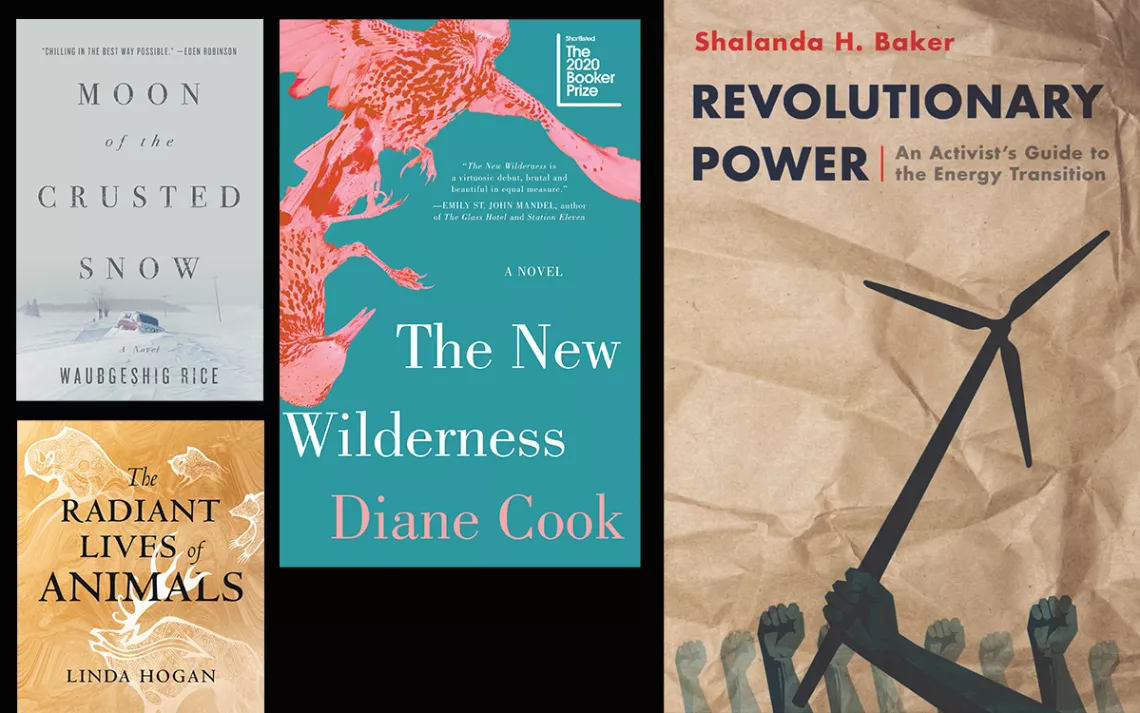
We may have turned the page on 2020, but the crises that defined such a historic year are still very much with us today—political, pandemic, and otherwise. As many of us continue to shelter in place, eager to move on from these troubled times, it's a moment to pause and consider what underlies the hard realities gripping the world today and how we can bring about a better tomorrow, one that is more connected and more just and has freed itself from legacy systems of injustice, exploitation, and oppression. These five books encourage us to remember where we started as we move toward an uncertain future, and in moving on, tap into the well of suffering, resilience, community consciousness, and grace that can bring us together and lead us forward.
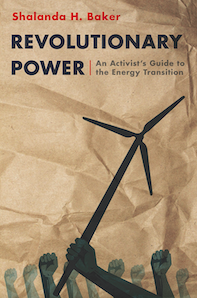
Revolutionary Power:
An Activist's Guide to the Energy Transition
by Shalanda H. Baker
Island Press, 2020
For a long time, Shalanda H. Baker wrote about energy and the US energy system in an objective, impersonal way. An expert in environmental and energy law at Northeastern University, she cofounded the Initiative for Energy Justice to support policymakers and frontline communities with research focused on a just and equitable transition away from fossil fuels to a clean energy system. Among her chief concerns was that policymakers and green groups were solely centering climate action in their work to achieve 100 percent clean energy instead of frontline, marginalized, and communities of color: the Black, brown, and Indigenous people disproportionately impacted by the fossil fuel industry and the climate crisis it has engendered.
It wasn’t until 2017, when Hurricane Harvey struck the Gulf of Mexico, that Baker realized she had a personal stake in that work. While reading the news late at night, she came across a Facebook Live video post from a young man in Port Arthur, Texas, that grabbed her attention. She knew Port Arthur: Her father grew up in the Carver Terrace housing projects there and worked for Entergy, a local energy company; she visited him in Port Arthur for the first time one summer when she was eight. In the video, the man said that floodwater from the hurricane was pushing past his ankles and rising. He pleaded for help.
It turned out she knew the man in the video as well. It was Baker’s half-brother.
“That’s when I realized: This is my work,” she told Sierra in an interview. “My lens is one of justice because of my lived experience.”
In Revolutionary Power: An Activist’s Guide to the Energy Transition, Baker methodically weaves the narrative threads of her own lived experience of energy insecurity and injustice with a resounding critique of how institutional structures of oppression make possible an energy system that exploits marginalized communities in the name of economic growth and American progress. Baker returns to a chief concern in her thesis: How do we transition from an exploitative, dirty energy system rife with structures of oppression to a just, renewable energy system without directly or indirectly replicating those oppressive structures? How do we pursue clean energy not only as a form of climate action but as a platform for civil rights? With a devastating critique of investor-owned utilities such as California's Pacific Gas & Electric and Hawai'i's Hawaiian Electric Company—and their built-in incentive strategies of high-risk, high-reward energy production—she provides a carefully crafted, methodical guide to how activists and green groups can center the ethics of community ownership, consultation, and equity in the campaign for 100 percent clean, renewable energy and still be in the fight against the climate crisis.
As a girl and throughout her young adult life, Baker lived with the reality of energy insecurity. She grew up in Austin, Texas, to a single mother. “Her limited salary as a government worker disqualified our family of three for any meaningful public assistance, but it was far from sufficient to keep our household afloat,” Baker writes. Her mother would often turn the lights off to save money on the electricity bill and "borrow from Peter to pay Paul." Poverty shaped her life there, as well as her father’s life. He moved to Port Arthur after the divorce and worked in various energy jobs like his own father before him.
The fossil fuel energy system perpetuates the climate crisis threatening our planet and is fueling the extreme weather events like the hurricane that struck Port Arthur in 2017. But it also enforces a system of institutionalized racism and social injustice—Port Arthur is just one example. This oil-rich region was once dubbed the Cancer Belt, seemingly linked to scores of petrochemical factories and poor air quality. "Lineage is a funny thing when you are Black in America," Baker writes. After visiting her father that one summer when she was eight, he died a few years later of heart disease at the young age of 53— the same disease that felled his older brother, who died at just 38. The energy burden families like Baker’s face is made worse by the reality that many live in “sacrifice zones”—the siting, without consultation, of polluting plants, factories, and other fossil-fuel-extraction projects and infrastructure that place disproportionate harm on traditionally marginalized and racial communities, polluting air, soil, and waterways.
“In its current design, the energy system requires a permanent underclass that can be exploited and from which resources can be extracted,” she writes. “We see this clearly in Port Arthur, but we can also observe this phenomenon around the United States and throughout the global economy. Pipelines and transmission lines cut through rural communities and Indigenous lands, rendering valuable natural resources useless and compromised.”
This structure of oppression is familiar to fossil fuel energy systems. Yet Baker also documents cases of clean energy projects that replicate those very same oppressive structures, and these too should give us pause. We follow her to Oaxaca, the second poorest state in Mexico and home to 14 distinct Indigenous groups, where she was shocked to find Indigenous people fighting against large-scale mega wind projects that had been sited on their land without consultation. From there, her field research takes us to Hawai'i, where in 2014, a bombshell report by the Hawai'i Public Utilities Commission chastised the local utility for its efforts to slow-walk the state’s renewable energy transition. In these and other examples she cites, traditionally marginalized communities are either not consulted or not given an ownership stake in the process. “The unwillingness to include equity at the outset of policy discussions concerning greenhouse gas mitigation and aggressive clean energy programs perpetuates the wedge between environmental organizations and communities of color and all but guarantees that the concerns of marginalized communities will be left out of ambitious energy policies,” she writes.
Other examples—including the release early last year of "Comprehensive Building Blocks for a Regenerative & Just 100% Policy," a toolkit written by frontline advocates and people of color working for a just transition to clean energy, and the establishing of green banks in Connecticut, New York, and Hawai'i to respond to the needs of low- to moderate-income communities in the clean energy transition—make a compelling case for the key principles of Baker’s new energy revolution: reforming the modern utility structure; a net-energy metering policy for rooftop solar; a community-based partnership and ownership model for energy policy; and access to finances to address existing energy burdens. For anyone looking to better understand what a clean energy system would look like under the Green New Deal, this is necessary reading.
With Revolutionary Power, Baker has delivered a seminal contribution to the growing body of literature on climate change and clean energy by engaging us all in an honest, cogent conversation about how energy systems too often center white, western, and male points of view, and she provides a clear and constructive road map for how policymakers and environmental activists can center instead the Black, brown, Indigenous, and other traditionally marginalized communities with whom climate justice must be decided in partnership.
A key question drives Baker’s thinking: Will the capitalism system and its Industrial Revolution “be redesigned to replicate the current structures of power and control, or will we reimagine our system to benefit those so often left out of discussions regarding system design?”
"It’s time to take the gloves off with this issue,” Baker told Sierra. “It’s such an emergency. We need to understand our own role and our own position in this broader emergency and transition.”
—Jonathan Hahn
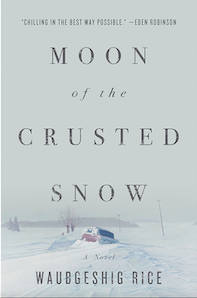
Moon of the Crusted Snow
by Waubgeshig Rice
ECW Press, 2018
When an Anishinaabe community in the far north of Canada loses contact with the outside world, no one is concerned at first. Power outages and cellular disruptions are not uncommon in this geographically isolated area. But as the weeks wear on, it becomes clear to the people who live there that an apocalyptic event has befallen the rest of civilization, and the town is left to struggle through the harsh winter with no modern conveniences and dwindling food supplies.
Published in 2018, Waubgeshig Rice’s debut novel has only become more salient with time, and some episodes are a bit too familiar (like the mass panic buying at the town’s only grocery store). It’s also—in the midst of our own grim pandemic winter—weirdly comforting to read, serving as a reminder that while things are bad right now, they could always be worse.
The main character, Evan Whitesky is a likable young father who spends the summer hunting and therefore is not wholly unprepared to meet the moment. Too many others, though, no longer bother with this rite of self-sufficiency and are ill-equipped for a season of scarcity. Rice is an astute observer of human nature, and in elegant, efficient prose, he documents the wide spectrum of behavior that emerges when societies are thrown into disarray. Those who are supposed to lead don’t, and the interplay between self-preservation and collective well-being gets messy.
Ultimately Evan and his family survive not only because of his practical skills but also because they are able to tap into a deep spiritual resilience born from generations of hardship—a kind of muscle memory of the suffering of their forebears. An elder reminds Evan that his people have already survived apocalypse, when they were stripped of their traditional land and forced to migrate north. They persevered then, and they’ll persevere now. Anishinaabe traditions, imperfectly practiced, endure nonetheless and serve as guideposts for Evan and his family as they grope their way toward a way of being that is both new and very old. Moon of the Crusted Snow is a fascinating examination of how our connection to the past can help us navigate a challenging and uncertain future.
—Wendy Becktold
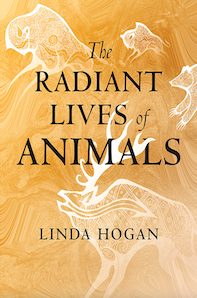
The Radiant Lives of Animals
by Linda Hogan
Beacon Press, 2020
Chickasaw poet Linda Hogan is concerned—as should be we all—with soul loss, “what happens as the world around us disappears.” It is, she notes, “a common condition in the modern world” brought about when people stand apart from nature. In The Radiant Lives of Animals, she proposes a remedy drawn from the traditions of Native America: a remembering of our place in the natural world and our commonality with the creatures whose paths we cross.
“A person seems so small, while outside them is the river, the mountain, the forest of fern and tree, the desert with its lizards. . . . The cure for soul loss is in the mist of the morning, the grass that grew a little through the night, the first warmth of this morning’s sunlight, and the human walking in a world infused with intelligence and spirit.”
That redemptive work—infusing the world with intelligence and spirit—is Hogan’s accomplishment here. While this book is scattered with poetry, it is also part memoir, part natural history, part Native American history. As such, it veers from quotidian details about, say, the expense of bringing a veterinarian to rural Oklahoma, to sudden lyric passages, as when she describes the fox den on her property in rural Colorado:
“I imagine their domestic inner world, dried roots at the top and everywhere the odor of rich fresh earth. I could burrow into the scent of it and sleep there. One day this will happen, in some way, whether ash or flesh, but for now I am merely observing life; the kits, perfectly soft, clean-furred through living in earth.”
Hogan’s appreciation for the animal world is not bounded. She gives equal attention to the wild and domestic, the deer, elk, and wolves that pass by her cabin and to her beloved cat, Sunshine, her rescue horses, the kingbird flycatchers who made a nest on her porch. “How could I not love you?” she writes of the latter. “I am a mere human being, slight in the world of all the other lives. Like your nest, there are depths in this world I do not know.”
Where her knowledge ends, she draws on the rich Native American tradition, both from her own Chickasaw people and many others. Native thinking suffuses this work, the accumulated wisdom of countless generations. She is painfully aware of how much of that learning her own people may have lost along the Trail of Tears when they were forced to relocate to the “Indian Country” of Oklahoma and celebrates the unbroken traditions of Navajo and Pueblo peoples. At an unnamed pueblo, she witnesses a deer dance that has been performed for thousands of years “and all the tomorrows,” and is struck by its power to conjure “parts of life before invasion, from inside the first world.”
The Radiant Lives of Animals is a melancholy book. Hogan feels the weight of departed family and friends, of the perfect pasture for grazing horses sold to a developer, of treasured animal friends who have died. She watches wolves cross her property and hopes they will evade the “shooters,” the same word she uses of those who massacred the bison upon which the Plains peoples depended. She notes the changing climate, increasing drought, melting glaciers. The kinship of humans with the animal world is increasingly tenuous.
And yet we can still hold on—by noting “when the elk bugle, the time of day a certain fox crosses from one hill to the next, when crows see a predator and group together to send it away.” Observation is an active good, a necessary humility. “Attention is the necessary act, and it is one from which we all benefit.”
—Paul Rauber
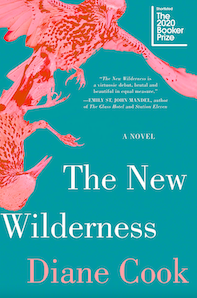
The New Wilderness
by Diane Cook
Harper, 2020
Stirring as it is, cli-fi, to me, can feel more suited to screenplay than novel—the conceptual notion of the work often trumps development of character and nuance of setting, whether by pointed design or the author intent. Not so in debut novelist Diane Cook’s The New Wilderness. It’s not surprising why this bleakly fascinating read was shortlisted for the 2020 Booker Prize—it concerns a mother, Bea, struggling to save a daughter made sick by the smog and pollution of over-developed metropolitan life. In Cook’s not-too-distant future, so many children are subject to this fate.
If they stay in the city, Bea knows young Agnes will die, but they have only one alternative: volunteering to become pawns in an experimental pilot program that transplants urbanites to the Wilderness State. There they live as nomadic hunter-gatherers and serve as fodder for academics studying how humans interact with nature. The world’s last vast expanse of untamed land is controlled by a vague and often foreboding state “administration.” And in Cook’s world (which is presumably a version of an America on or just past the brink of environmental collapse), the Wilderness State has become the most desirable place to exist.
It’s unpredictable, harsh, and marked by physical and existential danger, yet the protected and cordoned-off State is the last bit of pristine nature that remains in Cook’s America, all other land having long been designated for uses—there’s the Manufacturing Zone, the Woodlots, the Server Farms, the elite’s (probably mythical) “Private Lands,” and The City; i.e., the place to which all human life has been relegated. Bea and Agnes are among the first 20 experimentees allowed to traverse the Wilderness State as a community, but before long, the experiment’s waiting list counts tens of thousands of desperate city denizens—many of whom ultimately go to extreme lengths to smuggle themselves in, just so they can exist in the Wilderness as Trespassers (and thus, as enemies of the State).
Cook may not have access to any pandemic crystal balls, but it’s a chilling time nonetheless to consume her portrayal of a world in which city folk—led by the ones who can afford to—seek, with increasing desperation, to flee the respiratory problems of modern, industrialized life in favor of nature and lower population density. It’s a well-researched tale about living primitively—Cook clearly studied the early lifestyles of North American tribes such as the Ute and Diné.
It’s fun and sometimes salacious to follow the community (a unit whose leadership structure and personality archetypes call to mind sitcoms like Parks and Recreation). Cook may be at her most evocative when describing wildlife encounters, treacherous calderas, river crossings, and horrific injury, thirst, and hunger. But of course, the true peril lies within—the heart of this novel, its true story, is interpersonal. The further the group roams, the fiercer the power struggles grow—especially between Bea, who yearns for the City, and the increasingly feral, intrepid Agnes. Their ever-evolving dynamic—marked as it is by love, alienation, miscommunication, and primal longing—is where the book’s magic lies. Bea, the Community’s natural leader and greatest storyteller, early on identifies as a “bad mom.” Though this particular reader disagrees with Bea’s self-assessment, the relationship between the two complicated women is endlessly fascinating—head-strong Agnes must learn who she is with and without Bea, who at one point deserts her daughter and the Community. The similarities between the two women are often the source of their strife, which remains, in many ways, unresolved in the end.
Cook clearly likes to play with danger—and has the skills to do so to great effect. Optics-wise, The New Wilderness is a nature novel (and a masterful one at that), but what won me over was the unpredictability of its human nature, and the nuance of that portrayal. The novel causes the reader to wonder what truly became so unbearable in the city that its inhabitants decided to shirk creature comforts—why motherhood feels, as Bea states, “like a heavy coat she was compelled to put on each day no matter the weather”—and moreover, how to qualify the quality of the life we’ll all be living in the Anthropocene.
Cook leaves it all a little ambiguous. Because truthfully, none of us know—this is a novel with no linear answers, and thus no neat resolutions. Speculative fiction, at its best, forces us to consider the hard questions while we’re having fun (bleak, uneasy fun counts as fun these days). Which makes me appreciate this skillfully rendered work of cli-fi all the more—like any notion of our future in the Anthropocene, it’ll compel you, unsettle you, challenge you, and consider the sacrifices we’ll have to make, many of which, like the contents of this book, will not necessarily make us happy but will get us thinking about the communities and families we’ll build, moving into our uncertain future.
—Katie O'Reilly
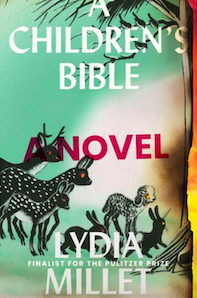
A Children’s Bible
by Lydia Millet
W.W. Norton and Company, 2020
At the start of A Children’s Bible, a group of families are vacationing together in an old house on a lake somewhere on the East Coast. The kids, mostly young high schoolers, are left to their own devices while the adults party. The teens band together, and what seems like an ordinary tale of teenage angst à la The Breakfast Club ensues.
Then a storm blows in, everything goes haywire, and The Breakfast Club quickly morphs into a storyline more akin to Lord of the Flies.
The plot stretches the boundaries of credulity—would the parents really be that inattentive with a hurricane bearing down? (The kids, for reasons I won’t go into, ride out most of the storm in a treehouse, and its aftermath on a nearby deserted farm.) It seems far-fetched, until you realize that it’s really just a metaphor. Adults are that clueless, living our lives business as usual while climate change, a force of destruction a lot worse than a hurricane, is in fact bearing down on our children.
Lydia Millet’s novel is, at its heart, a scathing indictment of adults—not of the climate deniers so much as the rest of us, those of us who know the facts but continue to stick our heads in the sand. The teens are profoundly alienated from their parents, most of all by the knowledge that their parents have essentially abandoned them in the face of an existential threat. A feeling of betrayal pervades the book.
“The parents insisted on denial as a tactic,” the main character, Evie, narrates. “Not science denial exactly—they were liberals. It was more a denial of reality.”
By the end, the story veers toward magical realism, a turn that, I’ll admit, took me by surprise. It’s at that point we realize that Evie is narrating the tale from the vantage point of a post-apocalyptic world. The summer at the house on the lake is from the before times, a symbolic Garden of Eden (Get it? Evie?). In fact, the whole world—the one we inhabit right now—is the Garden of Eden, and we’re all about to get kicked out for our sins, Millet seems to be telling us. It’s the ultimate fall from grace.
—Wendy Becktold
 The Magazine of The Sierra Club
The Magazine of The Sierra Club



